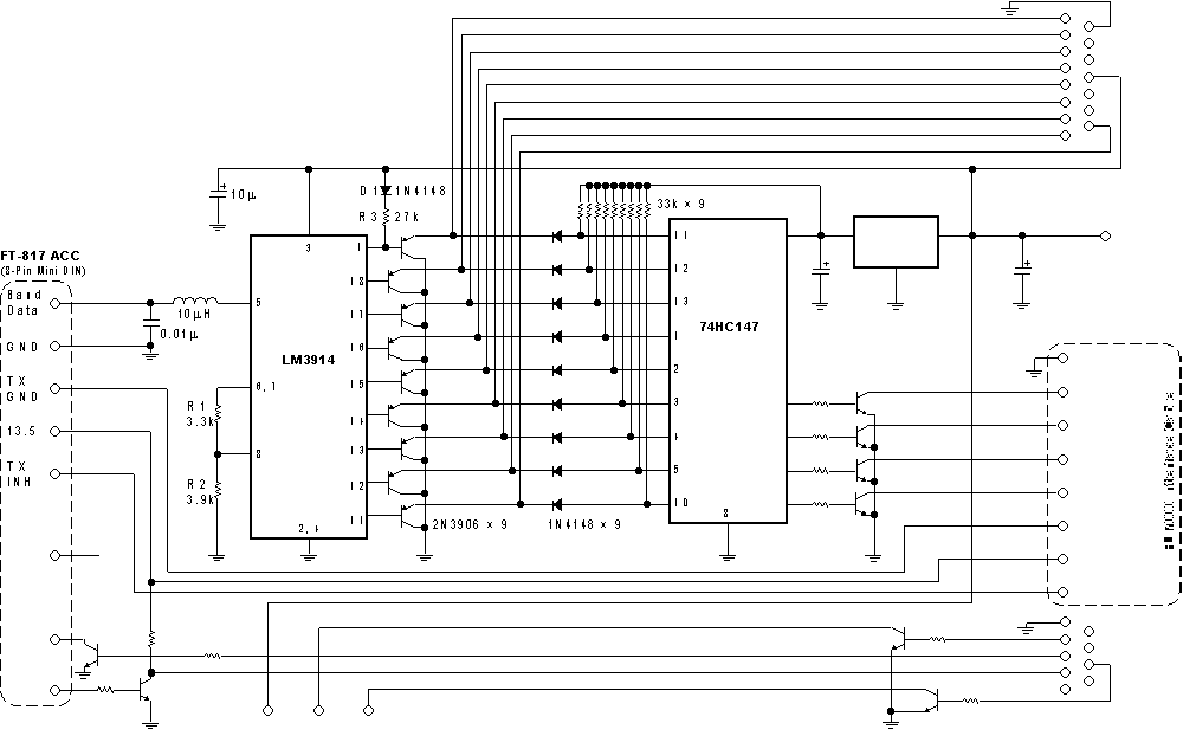

This project is an interface box for the Yaesu FT-817 that includes a band output port, a computer serial interface, and a remote interface for the FL-7000 (and Quadra?) solid state power amplifiers. The band output port drives things like relay-switched bandpass filters (BPF)—DuneStar 600 or ICE 419, for example—remote coax switches, etc., and does not require a computer. The serial interface allows rig control via computer, and makes logging programs like TR-Log and CT really shine (if the program supports the FT-817 protocol). The amplifier remote interface provides complete band switching and transmit/receive sequencing control for Yaesu solid state power amplifiers—change the band on the FT-817, and the amplifier follows automatically.
Figure 1 is the band select driver portion schematic. This is a modification of a design originally intended for Icom rigs, using an IC designed as a consumer-audio output meter as an analog-to-digital converter with an external reference and controlled-current output drivers. Yaesu uses different voltages for each band, but unlike Icom's scheme, decodes each of the twelve amateur bands separately.



The band decoder reads the "BAND DATA" voltage from the ACC jack on the rear panel of the FT-817. This voltage varies from 330mV for 160m to 4V for 70cm (440MHz), in steps of 330mV/band (see the Table, below, for theoretical values and measured voltages on my particular rig). The LM3914 is designed as an LED bar graph meter for low-cost consumer audio electronics. It is used in its "moving dot" mode instead of the bar graph mode, so only one output is active at a time. Note that no base current limiting resistors are needed for the output transistors: the LED driver functions as a current source which provides the needed base current limiting. Base current drive is set by R1, and is 3.3k ohms here. R2 works with R1 to scale the LM3914 to the 3V maximum value of BAND DATA in the HF bands. R3 and D1 compensate for a LM3914 "funny"—the first output draws several hundred microamperes of current even when the other outputs are selected., and this is enough to turn on the 160m driver slightly. R3 compensates by providing another path for this current. Its value might need tweaking for individual LM3914s and different supply voltages. D1 prevents reverse current flow from the relay into the rig, although is not really necessary—since the "+13.8V" pin on the ACC jack is always ON (even when the rig is powered down), I strongly recommend using a separate supply for the BPF relay drivers interface.
The computer serial interface is adapted from a design by "Russia Tomsk" that was modified by VE3CVG. Using voltage from the rig is acceptable here, since the normal current drain is zero. A normal 9-pin or 25-pin DB connector attaches to the computer's serial port.
Like most serial interfaces, getting the hardware built and connected is only part of the task; convincing the software in the computer and the radio to speak is usually much more frustrating, especially if you have not done it before with a given program or rig. Yaesu further muddies the waters by introducing different command sets with each radio model, so ensure your software understands FT-817-speak. You are on your own here!
The FL-7000 interface uses a 74HC147 priority encoder. It looks at the active low band data outputs and outputs four bits that represent the active band. The amplifier uses this code to select the proper internal bandpass filters. Keying is performed by the TX GND line, which is a direct connection between the open collector driver inside the 817 and the amplifier T/R line. TX INH is a timing line that limits drive power until the amplifier has switched into the transmit mode. Voltage must be applied to the amplifier's "+13.5" line or else the amplifier will not key. Nine 1N4148 diodes protect the 5V logic IC from the 12V coil voltage from the BPF relay bank.



Figure 2 shows the complete interface schematic. I tried to minimize the number of different resistor and capacitor values; only R1, R2, and R3 are semi-critical; the others may vary quite a bit without affecting circuit operation. The component cost of the full interface is relatively low: well under $20 at Digi-Key mail order prices. You can probably build this box for under $10 by visiting flea markets and the local electronics "junk stores".
73 & GL de Bob, K6XX
Copyright © 2001, Bob Wolbert, K6XX
Version 1.0 02MR01

Band Specified Measured
160m 0.33 0.336
80m 0.66 0.692
40m 1.0 1.03
30m 1.3 1.31
20m 1.6 1.65
17m 2.0 2.00
15m 2.3 2.34
12m 2.7 2.61
10m 3.0 2.95
6m† 3.3 3.31
2m† 3.7 3.64
70cm† 4.0 3.93
† Band not supported by this interface.

E-mail: Bob Wolbert, K6XX